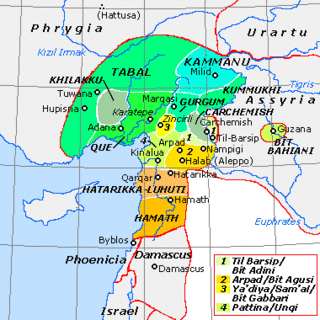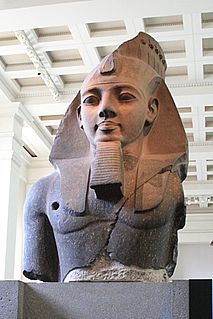Related Research Articles
The 1440s BC is a decade which lasted from 1449 BC to 1440 BC.

Mitanni, also called Hanigalbat or Hani-Rabbat in Assyrian or Naharin in Egyptian texts, was a Hurrian-speaking state in northern Syria and southeast Anatolia.

Thutmose III, sometimes called Thutmose the Great, was the sixth pharaoh of the Eighteenth Dynasty. Officially, Thutmose III ruled Egypt for almost 54 years and his reign is usually dated from 28 April 1479 BC to 11 March 1425 BC, from the age of two and until his death at age fifty-six; however, during the first 22 years of his reign, he was coregent with his stepmother and aunt, Hatshepsut, who was named the pharaoh. While he was shown first on surviving monuments, both were assigned the usual royal names and insignia and neither is given any obvious seniority over the other. Thutmose served as the head of Hatshepsut's armies. During the final two years of his reign, he appointed his son and successor, Amenhotep II, as his junior co-regent. His firstborn son and heir to the throne, Amenemhat, predeceased Thutmose III. He would become one of the most powerful pharaohs of the 18th dynasty.

Yamhad was an ancient Semitic kingdom centered on Ḥalab (Aleppo), Syria. The kingdom emerged at the end of the 19th century BC, and was ruled by the Yamhadite dynasty kings, who counted on both military and diplomacy to expand their realm. From the beginning of its establishment, the kingdom withstood the aggressions of its neighbors Mari, Qatna and Assyria, and was turned into the most powerful Syrian kingdom of its era through the actions of its king Yarim-Lim I. By the middle of the 18th century BC, most of Syria minus the south came under the authority of Yamhad, either as a direct possession or through vassalage, and for nearly a century and a half, Yamhad dominated northern, northwestern and eastern Syria, and had influence over small kingdoms in Mesopotamia at the borders of Elam. The kingdom was eventually destroyed by the Hittites, then annexed by Mitanni in the 16th century BC.

Kadesh, or Qadesh, was an ancient city of the Levant on or near the headwaters or a ford of the Orontes River. It was of some importance during the Late Bronze Age and is mentioned in the Amarna letters. It was the site of the Battle of Kadesh between the Hittite and Egyptian empires in the 13th century BC.

The Battle of Kadesh or Battle of Qadesh took place between the forces of the New Kingdom of Egypt under Ramesses II and the Hittite Empire under Muwatalli II at the city of Kadesh on the Orontes River, just upstream of Lake Homs near the modern Lebanon–Syria border.

Thutmose I was the third pharaoh of the 18th Dynasty of Egypt. He received the throne after the death of the previous king, Amenhotep I. During his reign, he campaigned deep into the Levant and Nubia, pushing the borders of Egypt farther than ever before in each region. He also built many temples in Egypt, and a tomb for himself in the Valley of the Kings; he is the first king confirmed to have done this.

Thutmose II was the fourth Pharaoh of the Eighteenth Dynasty of Egypt. His reign is generally dated from 1493 to 1479 BC. His body was found in the Deir el-Bahri Cache above the Mortuary Temple of Hatshepsut and can be viewed today in the National Museum of Egyptian Civilization in Cairo.

Amenhotep II was the seventh pharaoh of the Eighteenth Dynasty of Egypt. Amenhotep inherited a vast kingdom from his father Thutmose III, and held it by means of a few military campaigns in Syria; however, he fought much less than his father, and his reign saw the effective cessation of hostilities between Egypt and Mitanni, the major kingdoms vying for power in Syria. His reign is usually dated from 1427 to 1401 BC. His consort was Tiaa, who was barred from any prestige until Amenhotep's son, Thutmose IV, came into power.

The New Kingdom, also referred to as the Egyptian Empire, is the period in ancient Egyptian history between the sixteenth century BC and the eleventh century BC, covering the Eighteenth, Nineteenth, and Twentieth dynasties of Egypt. Radiocarbon dating places the exact beginning of the New Kingdom between 1570 BC and 1544 BC. The New Kingdom followed the Second Intermediate Period and was succeeded by the Third Intermediate Period. It was Egypt's most prosperous time and marked the peak of its power.

Qatna was an ancient city located in Homs Governorate, Syria. Its remains constitute a tell situated about 18 km (11 mi) northeast of Homs near the village of al-Mishrifeh. The city was an important center through most of the second millennium BC and in the first half of the first millennium BC. It contained one of the largest royal palaces of Bronze Age Syria and an intact royal tomb that has provided a great amount of archaeological evidence on the funerary habits of that period.

Carchemish, also spelled Karkemish was an important ancient capital in the northern part of the region of Syria. At times during its history the city was independent, but it was also part of the Mitanni, Hittite and Neo-Assyrian Empires. Today it is on the frontier between Turkey and Syria.

The siege of Dapur occurred as part of Pharaoh Ramesses II's campaign to suppress Galilee and conquer Syria in 1269 BC. He described his campaign on the wall of his mortuary temple, the Ramesseum in Thebes, Egypt. The inscriptions say that Dapur was "in the land of Hatti". Although Dapur has often been identified with Tabor in Canaan, Egyptologist Kenneth Kitchen argues that this identification is incorrect and that the Dapur in question was in Syria, north of Kadesh.

Mari was an ancient Semitic city-state in modern-day Syria. Its remains form a tell 11 kilometers north-west of Abu Kamal on the Euphrates River western bank, some 120 kilometers southeast of Deir ez-Zor. It flourished as a trade center and hegemonic state between 2900 BC and 1759 BC. The city was purposely built in the middle of the Euphrates trade routes between Sumer in the south and the Eblaite kingdom and the Levant in the west.

Hedjkheperre Setepenre Smendes was the founder of the Twenty-first Dynasty of Egypt and succeeded to the throne after burying Ramesses XI in Lower Egypt – territory which he controlled. His Egyptian nomen or birth name was actually Nesbanebdjed meaning "He of the Ram, Lord of Mendes", but it was translated into Greek as Smendes by later classical writers such as Josephus and Sextus Africanus. According to the Story of Wenamun from c. 1000 BC, Smendes was a governor of Lower Egypt during the Era of the Renaissance under the reign of Ramesses XI, however, Egyptologists have questioned the historical accuracy of that story.

Ramesses II was the third pharaoh of the Nineteenth Dynasty of Egypt. He is often regarded as the greatest, most celebrated, and most powerful pharaoh of the New Kingdom, itself the most powerful period of Ancient Egypt.

The Eighteenth Dynasty of Egypt is classified as the first dynasty of the New Kingdom of Egypt, the era in which ancient Egypt achieved the peak of its power. The Eighteenth Dynasty spanned the period from 1550/1549 to 1292 BC. This dynasty is also known as the Thutmosid Dynasty for the four pharaohs named Thutmose.
Sumu-Epuh is the first attested king of Yamhad (Halab). He founded the Yamhad dynasty which controlled northern Syria throughout the 17th and 18th centuries BC.
Urshu, Warsuwa or Urshum was a Hurrian-Amorite city-state in southern Turkey, probably located on the west bank of the Euphrates, and north of Carchemish.
Hassum was a Hurrian city-state, located in southern Turkey most probably on the Euphrates river north of Carchemish.
References
- Madeleine Lurton Burke, “Ganibatim ville du Moyen Euphrate,” Revue d’Assyriologie 55 (1961) p. 147-151.
- Kenneth A. Kitchen, Ramesside Inscriptions, Translated & Annotated Notes and Comments Volume II: Ramesses II, Royal Inscriptions, (Blackwell Publishers, Oxford, England) 1999.
- Abdel-Aziz Saleh, “The GNBTYW of Thutmosis III's Annals and the South Arabian GEB(B)ANITAE of the Classical Writers,” Bulletin de l'Institut Francais d'Archeaologie Orientale 72 (1972) p. 245-262.
- Itamar Singer, “The Kurushtama Treaty Revisited,” p. 591-607 in SHARNIKZEL Hethitologische Studien Zum Gedenken an Emil Orgetorix Forrer edited by Detlev Groddek and Sylvester Rößle, Dresdner Beiträge zur Hethitologie, Band 10, 2004.
- Herbert A. Storck, “Ganibatum and Gnbtyw,” Journal of Ancient Civilizations 21 (2005) p. 113-123.